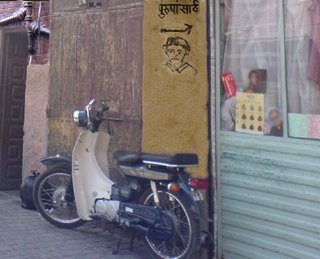
Going to Elephanta caves on the weekend was always an adventure. Located in Gharapuri Island off the coast of Bombay, (a UNESCO world heritage site) they feature rock-cut sculptures of Hindu mythology. You can reach the caves by boat from Gateway of India.
The history printed on the travel brochures about the caves is incomplete if not outright wrong. Walking around the caves looking for clues that the travel writers missed (or chose to miss) is a sense of adventure. The caves feature history of violence, forced assimilation and religious intolerance just barely under the surface (literally, in this case), you just have to know where to look.
First of all, the caves pre-date the 600 AD date most historians ascribe to it; they are clearly of pre-Satavahana period. The caves were decidedly Buddhist in their first incarnation and if you walk around the caves and pay close attention, you can see various signs of over-sculpting by later Hindu attempted to change the appearance of the original caves. Typical Buddhist sculptural features (statue of Kubera etc.) are over-sculpted with Hindu faces and the Chaitya hall itself has been converted to a room for Shiva. Similar attemptes have been made at Ajanta and Ellora. The better evidence of its pre-history can be seen if you move past the tourist attractions of the major caves and into the minor less-adorned caves in the back. It must have been a terrible feat of hardwork to sculpt these marvelous reliefs onto the rock surface considering that this is basalt and not sandstone or some such softer material.
The later part of history is equally disturbing. The Portuguese used the sculptures for target-practice and you can still see severe damage from this activity.
A friend of mine (who is now a professor of Ancient Indian Culture, was working with a professor from Michigan on dating the caves and determining the evidence for over-sculpting. I had the good fortune of hanging out with her in the caves looking at the seepage and water destruction one summer. All this information was gleaned from those trips.
The best part of going to Elephanta was the boat journey itself. Board the boat from the Gateway and it is about 40 minutes to get across the narrow channel the seperates the island from the mainland. There were always the cheerful Indian tourists on weekends, with lots of food going across to picnic in the areas around the caves. Jovial Maharashtrian women with young children and grim-faced husbands spent the entire time shouting at their children in a mock-serious tone. There were a few like us, who were not easy to categorize. And then we have the phoren tourists, those apple-cheeked lobsters from Europe who carried their travel books and cameras in full display and were kind if aloof to the native children. I once remember seeing a woman of Indian descent traveling with her white male companion (husband?) who spent the entire time pressing his hands against her breasts and he seemed the least interested in this.
My favorite thing to do was to lean over and let my face be sprayed on by the jet. It was the days before I became conscious of the raw sewage that was dumped onto the sea and so it made for good fun. I never had any facial allergies from this.
Apparently the hidden places behind the caves are where the local youngsters go to drink and have sex. It was corroborated by a few participants themselves. The caves are technically a no-man's land. I don't know who polices it, and when.
During the late Satavahana period, when Buddhists were persecuted and Hinduism re-emerged as the dominant religion, most of the accessible caves were re-converted to Hindu places of worship. In fact, I am not even sure if all were even used as sites of worship. This is the background for Ajanta and Ellora and less famously Elephanta.
The real context of the caves don't become apparent until one visits other Buddhist caves in Maharashtra and see how they escaped molestation mostly because of their remote location. In Bombay, one can see wonderful Chaityas and viharas well preserved in Kanheri caves in Borivali national park. (I will write about discovering the back part of the cave complex on a hike from Thane to Borivali some other time.) Near Bombay, Lohgadh-Visapur complex is another worth noting. While this is very controversial, there is significant evidence that most of the forts attributed to Shivaji in Maharashtra were constructed during the Buddhist period and Shivaji merely maintained it. Unfortunately, there is no easy way to get to these places other than hikes. Get off the local train at mid night, camp in the local station and start hiking at 4 AM when the sky is pitch black and full of a million stars. You get to the top around 10 AM and the view is spectacular. That is what we used to do.
After a long day spent in the caves, one gets back to the city hot, sweaty and tired. How can you end the journey without a cold one at Cafe Mondegars (Mondy's)? Who is up for a hike?